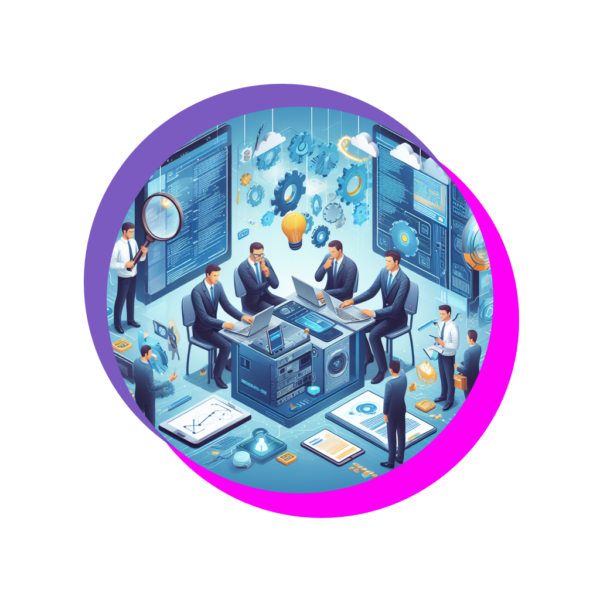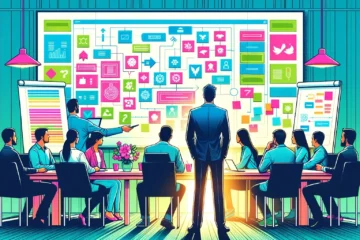In the high-stakes game of startup exits, where dreams meet million-dollar valuations, technical due diligence (TDD) is often the unsung hero. While financial and legal audits grab the headlines, it’s the deep dive into a startup’s technology that can expose hidden gems or uncover buried landmines, ultimately determining the success or failure of an acquisition. Despite its importance, many startups overlook TDD, leading to a higher failure rate of 90% for startups.
Navigating the “tech jungle” can be tricky. That’s where CTOs (Chief Technology Officers) can play a pivotal role in guiding startups toward a prosperous future. As a CTO, who manages the engineering teams, I have insights and facts from practice about Technology Due Diligence for Startup Exits. So lets dive into the theme on the Artelogic blog!
What exactly does Technical Due Diligence involve?
Technical Due Diligence (TDD) is a thorough examination of a company’s technology and technical aspects before a significant event like an investment, merger/acquisition, or initial public offering (IPO). To my short example, it’s like diving deep into a car’s engine before buying it – you want to know if it runs smoothly, has any hidden faults, and is worth the price.
- For Investors, due diligence means reducing risks and helping them make informed investment decisions.
- For Startups, due diligence means identifying weaknesses, improving products and processes, and building trust with investors.
Technology due diligence consulting involves evaluating the technical aspects of a business or project to assess its risks and potential. CTOs, with their keen eye for technical intricacies, play a crucial role in the Technical Due Diligence (TDD) process. They delve into the code, assess the architecture, scrutinize infrastructure, and evaluate development practices.
For example, they ask the tough questions:
- Is the technology scalable and secure enough to handle future growth?
- Are there any hidden technical debts that could cripple the product down the line?
- Does the development team have the expertise and processes to maintain and evolve the technology?
- Are there any intellectual property risks associated with the technology?
In my opinion, by answering these questions and more, TDD provides invaluable insights that go beyond just numbers on a spreadsheet. It paints a clear picture of the technical landscape, allowing investors and acquirers to make informed decisions based on real-world risks and potential.
Is Due Diligence Your Secret Weapon?
While financial and legal due diligence for IT are standard practice, TDD offers a deep dive into the heart of a startup’s technology infrastructure.
Why does the importance of due diligence for startups? Here’s why TDD is critical for maximizing your startup’s exit value and ensuring a smooth transition:
1. Unmasking hidden liabilities
Technical debt, outdated tech stacks, and security vulnerabilities can lurk beneath the surface, posing significant long-term risks for acquirers and investors. TDD exposes these issues, allowing for informed negotiation and mitigation strategies and safeguarding future stability.
2. Validating scalability and maintainability
Is the startup’s technology designed to handle explosive growth? Can it adapt to evolving market demands? TDD assesses the tech infrastructure’s capacity and flexibility, ensuring it’s not a fragile house of cards waiting to collapse.
3. Building trust and confidence
A comprehensive TDD report showcases the strength and reliability of your technology. Thorough technology due diligence in mergers and acquisitions is crucial for uncovering hidden risks and maximizing deal value. Moreover, investors conducted thorough due diligence startup before making any financial commitments.
4. Smoothing the transition
TDD facilitates a seamless post-acquisition or IPO transition by identifying potential integration challenges and dependencies early on. IT due diligence M&A highlights potential tech risks in M&A deals, safeguarding your future. This minimizes disruption, reduces costs, and ensures a quicker path to success for new owners.
5. Mitigating post-deal surprises
No one wants to inherit a tech nightmare after closing the deal. TDD flags potential bugs, security flaws, and maintenance concerns, allowing for proactive solutions and preventing costly surprises down the line.
Moreover, investors often rely on comprehensive M&A due diligence assessments to ensure the target company’s financial health and market suitability align with their expectations. The company engaged in technology diligence to assess the security and efficiency of its software systems.
Technical Due Diligence Checklist: Key Components & Questions
Investing in a tech company brings excitement, but to my mind, also the necessity of a thorough evaluation. A crucial step in ensuring success is the meticulous execution of a due diligence checklist technology, empowering entrepreneurs to navigate the complexities of innovation and technological integration with precision and foresight.

This IT due diligence checklist focuses on four key components and the questions you should ask to assess each one:
1. Technical Team: The Minds Behind
- Who’s who? Map out the team’s composition. Understand roles, responsibilities, and areas of expertise. Knowing who leads development, who crafts the code, and who steers QA is essential.
- Decision-making dynamics: Identify who calls the shots. A clear decision-making structure prevents confusion and ensures accountability.
- Competence and reliability: Scrutinize their skills and experience. Look for relevant track records, successful projects, and proven technical prowess. Don’t hesitate to request resumes and references.
- Responsibility alignment: Ensure roles and responsibilities align with team members’ qualifications. Mismatched skills can lead to inefficiencies and project roadblocks.
- Organizational structure: Understand how the team functions. Are they siloed or collaborative? How do they communicate and manage tasks? A cohesive team spirit fosters innovation and problem-solving.
- Team size and agility: Does the team’s size match the project’s complexity? Can they adapt to changes in personnel or project scope without compromising quality? Flexibility is key in the dynamic tech landscape.
- Feedback culture: How does the team handle internal feedback? Do they embrace constructive criticism and learn from mistakes? A growth mindset is crucial for continuous improvement.
2. Process: The Well-Oiled Machine
- Business-tech harmony: Assess the synchronization between development and business goals. Are both teams aligned on priorities and roadmap execution? Misalignment can lead to wasted resources and unmet expectations.
- Product and tech roadmap clarity: Evaluate the roadmap’s detail and feasibility. Are features clearly defined with realistic timelines? A well-defined roadmap keeps everyone on the same page and drives progress.
- Production quality: Analyze the existing development and deployment processes. Are they efficient, streamlined, and error-prone? Continuous improvement in production processes ensures consistent quality and timely delivery.
- Adaptive to change: Can the process evolve to accommodate business and tech team adjustments? Rigidity can stifle innovation and hinder progress in a fast-paced industry.
- Disaster recovery preparedness: Does the company have a plan for system or product failures? Is there a clear course of action to minimize downtime and maintain user trust? Proactive planning demonstrates responsible leadership.
3. Product: The Heart of the Matter
- Roadmap with detail: Does the product development roadmap extend at least a year ahead? Are feature specifications comprehensive and well-defined? A clear roadmap builds confidence and allows for informed investment decisions.
- Long-term growth vision: Understand the company’s plan for product evolution and market reach. Is there a sustainable strategy for maintaining relevance and attracting new users? A compelling vision inspires confidence in the product’s future.
- Roadmap execution readiness: Can the team currently deliver on the planned features? Do they have the resources, skills, and infrastructure to meet their commitments? Overly ambitious roadmaps can set unrealistic expectations.
- Dedicated product team: Is there a dedicated team solely focused on product strategy and development? A clear ownership structure ensures focus and accountability for product success.
- Data quality and compliance (if applicable): If your investment hinges on data, assess its quality, security, and adherence to relevant privacy regulations. Data integrity and compliance are crucial for building trust and avoiding legal pitfalls.
- Technical documentation: Comprehensive and clear product documentation simplifies maintenance, future development, and onboarding new team members. Incomplete or ambiguous documentation can lead to confusion and inefficiencies.
4. Technology: The Foundation of Success
- Architecture and infrastructure: Understand the underlying technical framework. Is it scalable, secure, and reliable? Does it align with the product’s needs and growth trajectory? A robust architecture ensures long-term sustainability.
- Security measures: Evaluate the implemented security protocols. Are they comprehensive and up-to-date? Protecting user data and system integrity is paramount in today’s digital landscape.
- Code quality: Analyze the codebase for clarity, efficiency, and maintainability. Is it modular, well-documented, and easy to understand? Clean code simplifies future development and reduces technical debt.
- Quality assurance: Assess the existing QA procedures. Are they thorough, automated, and integrated into the development process? Robust QA practices deliver quality products and minimize bugs.
- Testability: Determine the ease and completeness of software testing practices. Can the product be effectively tested across different platforms and scenarios? Comprehensive testing builds user confidence and reduces post-release issues.
- Open source or scratch-built: Understand the code’s origin story. Is it built from scratch or based on open-source frameworks? Each approach has its advantages and disadvantages.
Bonus Tips:
- Involve your technical team in the tech diligence process for expert insights.
- Set realistic expectations based on the company’s stage and market.
- Don’t hesitate to request additional information or clarification when needed.
To my mind, by taking a proactive approach to due diligence technology, you can set yourself up for success in the ever-evolving world of technology investments. With each tick on the VC due diligence checklist, a startup inches closer to securing the fuel for its rocket ship journey. So save this tech due diligence checklist.
Tech Due Diligence Failure: Key Factors
According to McKinsey & Company, startups that perform due diligence on the target’s technology are 2.8 times more likely to achieve a successful outcome than those that don’t. But what about the factors of failure? Here are some key factors that can contribute to tech due diligence failure:
1. Inadequate Scope and Depth:
- Incomplete data: Limiting the due diligence scope to readily available data can miss crucial information hidden in internal systems, legacy platforms, or third-party integrations.
- Shallow analysis: Failing to delve deep enough into technical infrastructure, code quality, and security vulnerabilities can leave major risks undetected.
- Neglecting non-technical aspects: Overlooking human resources, organizational culture, and potential integration challenges can lead to post-merger friction and disruption.
2. Lack of Expertise:
- Assigning unqualified personnel: Entrusting the engineering due diligence process to individuals without sufficient technical knowledge or experience can lead to misinterpretations and missed red flags.
- Failing to involve specialized teams: Depending solely on in-house resources, founders might miss crucial insights that external experts in specific technology areas or legal matters could provide.
3. Time Pressures and Budget Constraints:
- Rushing the process: Pressures to close the deal quickly can lead to shortcuts and missed opportunities for a thorough investigation.
- Cutting corners on resources: Inadequate budget allocation for due diligence can limit the scope of the investigation and the quality of expertise engaged.
4. Overlooking Cultural Differences:
- Misunderstanding communication styles: Cultural differences in communication styles can lead to misunderstandings and missed information during the due diligence process.
- Failing to assess cultural fit: Neglecting the potential clash between the acquiring and acquired company cultures can lead to post-merger integration challenges.
5. Reliance on Outdated Methodologies:
- Failing to adapt to evolving technologies: Due diligence methodologies need to keep pace with rapid technological advancements to assess emerging risks and opportunities effectively.
- Overreliance on traditional financial metrics: While financial metrics are important, they might not fully capture the value and potential risks associated with tech assets.
Avoiding Tech Due Diligence Failure
By understanding these key factors that can lead to failure, companies can take steps to mitigate risks and ensure a successful tech due diligence process. Here are some recommendations:
- Define a comprehensive scope and depth for the due diligence based on the specific deal and technology involved.
- Assemble a team of qualified experts with relevant technical knowledge and experience.
- Allocate sufficient time and resources to conduct a thorough and insightful investigation.
- Bridge cultural gaps through open communication and clear expectations.
- Utilize up-to-date methodologies and tools tailored to the specific tech landscape.
In my opinion, by proactively addressing these potential pitfalls, companies can increase their chances of conducting a successful tech due diligence process, ultimately leading to smoother integrations, reduced risks, and greater value creation from their acquisitions and mergers.
Technical Due Diligence Best Practices
Proper technical due diligence consulting is crucial for informed decision-making in tech-related investments and acquisitions, whether you’re on the receiving or performing end. Let’s dive into some key Do’s and Don’ts for a successful TDD process:
Do’s:
- Align with the thesis: Understanding the investment/acquisition goals and expected outcomes before diving in. Tailor your TDD scope to identify potential deal breakers and value drivers that support those goals.
- Assemble the right team: Build a team with diverse technology, business, and security expertise to ensure a comprehensive assessment. Consider the target company’s specific technology stack and needs. The success relied heavily on the thoroughness of the experienced analysts’ due diligence assessment.
- Plan efficiently: Create a detailed TDD plan that outlines data requests, interviews, code reviews, and timelines. This ensures a smooth process and avoids wasting time on irrelevant areas.
- Focus on people and processes: Evaluate the target company’s technical team, their expertise, communication skills, and development processes. Strong talent and efficient workflows can mitigate technology risks.
- Analyze code, architecture, and infrastructure: Conduct thorough code reviews, assess the system architecture for scalability and maintainability, and evaluate the infrastructure’s reliability and security posture.
- Evaluate data security and privacy: Assess data handling practices, compliance with relevant regulations, and potential vulnerabilities. Data breaches can be costly and damaging.
- Maintain communication and transparency: Keep both parties informed throughout the process. Share findings and address concerns promptly to build trust and facilitate smooth negotiations.
- Prepare for integration: If integration is expected, consider potential technical challenges and compatibility issues between the two systems. Early planning can prevent future headaches.
- M&A IT due diligence is no longer an afterthought; it’s a crucial step in mitigating technology integration risks and maximizing post-merger synergy.
Don’ts:
- Overlook documentation: Review critical documentation like code reviews, system design documents, and security audits. A lack of proper documentation can indicate hidden problems.
- Focus solely on technology: While technology is vital, don’t ignore other crucial aspects like market opportunities, customer base, and competitive landscape.
- Underestimate technical debt: Look for signs of “shortcut” solutions and unsustainable growth practices that could lead to future issues and increased costs.
- Overlook compliance and regulations: Ignore risks arising from non-compliance with relevant regulations or data privacy laws. This can lead to legal and financial complications.
- Rush the process: Thorough TDD takes time. Rushing the process can lead to missed red flags and inaccurate assessments.
- Ignore cultural fit: Assess the technical team’s culture and alignment with your own. Communication and collaboration challenges can hinder integration efforts.
- Base decisions solely on price: Don’t let a tempting price cloud your judgment. Technical issues and integration complexities can outweigh initial cost savings.
- Neglect communication: Poor communication can breed mistrust and hinder deal progress. Be transparent, promptly address concerns, and maintain open dialogue.
By following these Do’s and Don’ts, you can navigate the TDD process effectively, gain valuable insights, and make informed decisions for successful tech investments and acquisitions.
Remember, TDD is not just about identifying risks; it’s also about uncovering hidden potential and opportunities. Conducting a thorough and rigorous assessment can set you up for a mutually beneficial partnership that drives long-term growth and success.
Benefits of TDD Guided by CTOs
Building a successful startup takes more than just a great idea. You need a strong team, a clear vision, and the right resources to navigate the dynamic tech landscape. One crucial figure can make all the difference: a Chief Technology Officer (CTO).
To my mind, here’s how a CTO can supercharge your startup in 7 key areas:
- Tech Stack Mastermind: Choosing the right tools and architecture is crucial. A CTO helps you select the perfect tech stack, design scalable systems, and ensure your infrastructure can handle explosive growth.
- Product Development Roadmap: A clear product roadmap keeps your startup focused. CTOs craft achievable milestones, set timelines, and define technical requirements to deliver what matters most.
- Team: A skilled and motivated technical team is vital. CTOs guide you in finding the right talent, establishing efficient processes, and fostering a thriving engineering culture.
- Cost Optimization: Every penny counts. CTOs optimize your tech budget, identify cost-saving opportunities, and help choose the most cost-effective vendors and partners.
- Risk Mitigation: From technical glitches to market shifts, threats abound. CTOs identify potential risks and develop strategies to mitigate them, ensuring your startup operates smoothly.
- Mentorship: Technology evolves at breakneck speed. CTOs keep you ahead of the curve, identifying the latest trends and innovations that can put your startup ahead of the pack.
- Exit Strategy: Got an exit plan? A CTO prepares your tech infrastructure for maximum value, whether it’s an acquisition or an IPO.
By leveraging the expertise of a CTO, you can make informed decisions, operate efficiently, and achieve long-term success. Remember, TDD is not a one-time event. It’s an ongoing process that should be integrated throughout the entire exit journey, from initial due diligence to post-acquisition integration.
Bonus: Template for a technical due diligence report for a startup at the exit stage
- Executive Summary
- Brief overview of the startup and the purpose of the technical due diligence.
- Key findings and overall technical health assessment.
- Company Overview
- History and background of the startup.
- Business model and value proposition.
- Overview of products/services offered.
- Technology Stack and Architecture
- Detailed description of the technology stack (programming languages, databases, frameworks, etc.).
- Architecture diagrams and explanations.
- Assessment of scalability, maintainability, and security of the architecture.
- Product Analysis
- Detailed review of the key products/services.
- Usability, functionality, and performance analysis.
- Feedback from customers/users, if available.
- Development Practices and Processes
- Overview of the software development lifecycle.
- Quality assurance and testing processes.
- Source code management, deployment processes, and documentation.
- Technical Team and Expertise
- Profiles of key technical team members.
- Description of team structure and management practices.
- Skills assessment and training programs, if any.
- Intellectual Property and Compliance
- Inventory of intellectual property (patents, trademarks, copyrights).
- Compliance with relevant industry standards and regulations.
- Licensing agreements and third-party dependencies.
- Data Management and Security
- Data architecture and management practices.
- Security protocols and history of security incidents.
- Data privacy policies and compliance with data protection laws.
- Operational Infrastructure
- Overview of IT and network infrastructure.
- Disaster Recovery and Business Continuity Plans.
- Support and maintenance systems.
- Financials and Expenditure on Technology
- Overview of technology-related expenses.
- Investment in R&D and future technology plans.
- Analysis of the cost-effectiveness of the technology investments.
- Risks and Challenges
- Identification of major technical risks and challenges.
- Assessment of potential impact and mitigation strategies.
- Conclusion and Recommendations
- Final assessment of the technical health of the startup.
- Recommendations for addressing any identified issues.
- Overall potential of the startup from a technical perspective.
If your business needs assistance in preparation for Technical Due Diligence, our certified engineers and IT experts are ready to support you. Book the discovery meeting now!


















